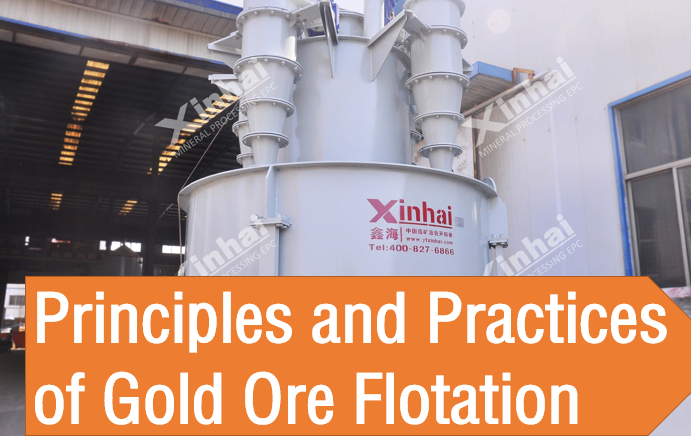Principles and Practices of Gold Ore Flotation
2025-08-07 Xinhai (1116)
2025-08-07 Xinhai (1116)
If you have any questions, please contact us through the following ways, we will give you more and better assistance!

Gold ore flotation is a crucial method for gold extraction, particularly suitable for processing fine-grained, low-grade gold ores. By optimizing flotation processes and reagent systems, efficient separation of gold from gangue minerals can be achieved, significantly improving gold recovery rates. The following elaborates on ore characteristic analysis, key flotation links, and directions for process optimization.
1. Ore Characteristics Basis for Gold Ore Flotation
The flotation effect of gold ores is closely related to the occurrence state of gold. Precious metal minerals such as native gold and electrum usually exist in fine-grained forms (0.015~0.033mm), mostly in exposed or semi-exposed states (accounting for over 90%), mainly embedded in fractures or intergranular spaces of gangue minerals like quartz and carbonates, with some encapsulated by limonite and sulfides (accounting for about 10%). The distribution characteristics of gangue minerals such as quartz and barite, as well as the content of carbonaceous substances in the ore, affect flotation selectivity—carbonaceous ores may reduce recovery due to carbon adsorption of gold, requiring targeted pretreatment.

2. Core Process Links of Gold Ore Flotation
1. Pretreatment: Crushing and Grinding
Crushing adopts a one-stage open-circuit process to crush raw ore to approximately 40mm, with a grizzly screen controlling particle size to avoid large ore blocks affecting subsequent operations. In the grinding stage, ore needs to be refined to -0.074mm fraction accounting for about 75%. Overflow ball mills combined with submerged spiral classifiers or hydrocyclones are commonly used to ensure full dissociation of gold particles while preventing slime interference caused by over-grinding.
2. Flotation Reagent System
o Collectors: Xanthates and dithiophosphates are commonly used to enhance the hydrophobicity of gold particle surfaces, making them easily attach to bubbles;
o Frothers: Such as pine oil, which stabilizes bubbles and expands the gas-liquid interface to improve gold particle capture efficiency;
o Modifiers: Sodium carbonate (adjusting pH to 8~10) or lime is added according to pulp pH to inhibit gangue minerals (e.g., silicates) and eliminate the impact of harmful ions (e.g., arsenic, antimony).
3. Flotation Process Design
A three-stage process of "roughing-cleaning-scavenging" is adopted: roughing recovers most floatable gold particles; cleaning improves concentrate grade through multiple enrichments; scavenging targets unrecovered gold particles in tailings to reduce losses. For carbonaceous gold ores, pretreatment steps (such as roasting or bleaching) can be added to reduce carbon adsorption interference on gold.
4. Subsequent Treatment: Leaching and Recovery
Flotation concentrates are concentrated and then enter the leaching stage. Gold is dissolved using cyanidation or cyanide-free reagents, and gold-cyanide complexes are adsorbed by activated carbon. Desorption uses high-temperature and high-pressure equipment with sodium hydroxide solution as the desorption agent. Finally, high-purity gold mud is obtained through electrolytic deposition, and alloy gold is produced after smelting.
3. Directions for Process Optimization
1. Enhancing Dissociation Efficiency: Optimize grinding media and rotation speed to reduce gold particle encapsulation rate;
2. Development of Environmental-Friendly Reagents: Promote cyanide-free collectors and low-toxic modifiers to reduce environmental pollution;
3. Intelligent Control: Real-time adjust reagent dosage and flotation time by online monitoring of pulp concentration, pH, and other parameters to improve stability.
By combining ore characteristics with technological innovation, gold ore flotation processes can efficiently recover fine-grained gold while balancing economic benefits and environmental requirements, providing key technical support for the sustainable development of gold resources.